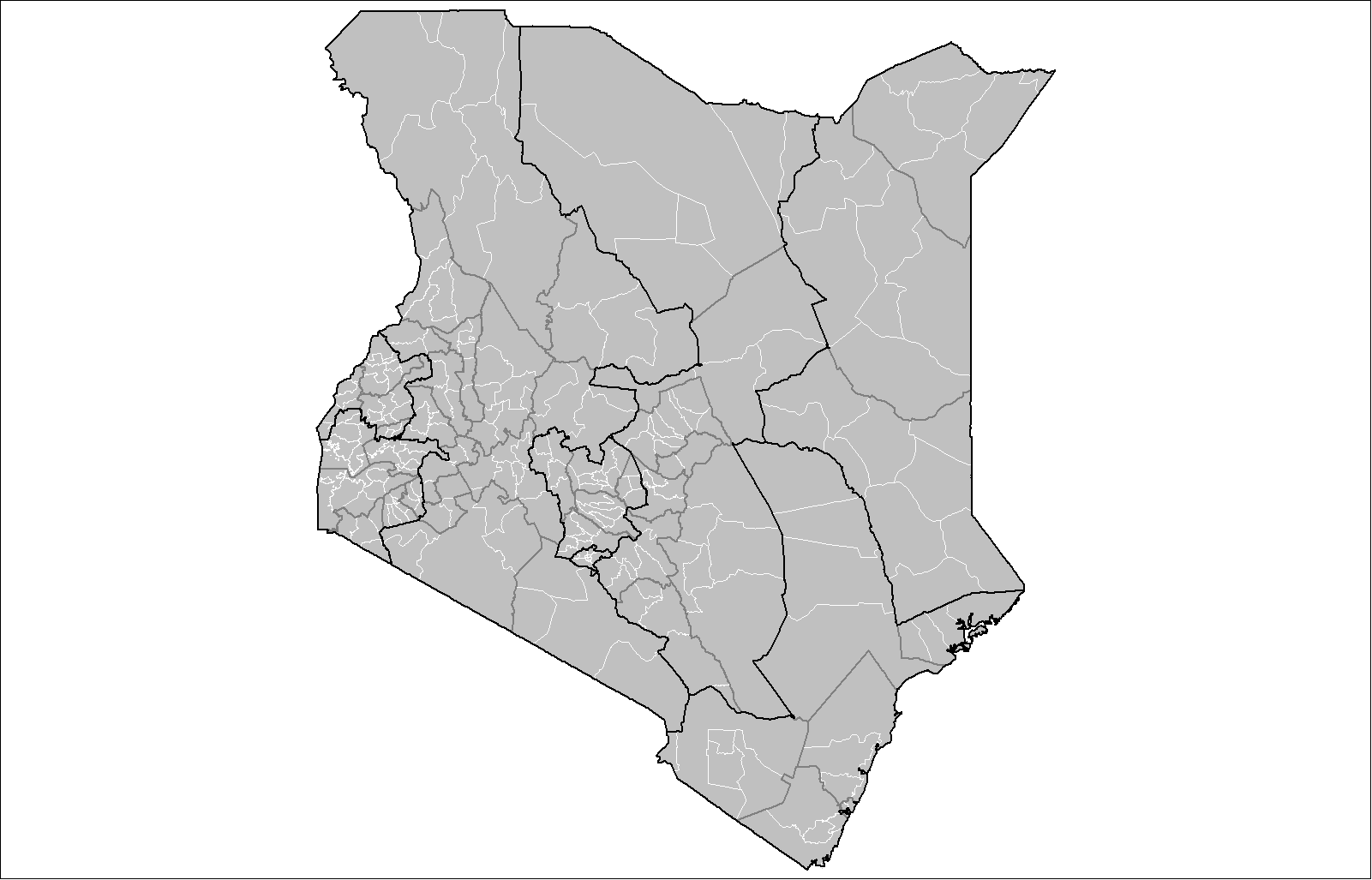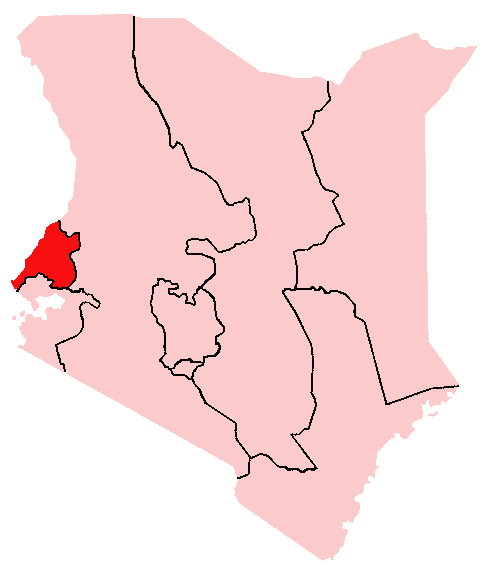|
Moi's Bridge
Moi's Bridge is a small town that has its roots both in Uasin Gishu County, Trans Nzoia County and Kakamega County, Kenya. It is a town that has since grown as an agricultural center with the third largest NCPB in East Africa. Moi's Bridge is an electoral ward of the Soy Constituency and Uasin Gishu County. It is an important Kenyan area, often named as the 'bread basket' of Kenya. Moi's Bridge is also a location in the Soy division of Uasin Gishu District. Etymology The town is named for the bridge across the Nzoia River which it grew around and as a result of. It was initially named Hoey's Bridge after Cecil Hoey, the original builder of the bridge. The name later changed to Moi's Bridge after independence, named after the second president Hon Daniel Toroitich arap Moi. History Cecil Hoey, one of the first European residents in the Trans-Nzoia region built a bridge across the Nzoia River so as to drive his ox teams over. A small settlement grew up around the bridge and this gr ... [...More Info...] [...Related Items...] OR: [Wikipedia] [Google] [Baidu] |
Uasin Gishu County
Uasin Gishu County is one of the 47 counties of Kenya, counties of Kenya located in the former Rift Valley Province. Eldoret has the county's largest population center as well as its administrative and commercial center. “It lies between longitudes 34 degrees 50’ east and 35 degrees 37’ West and latitudes 0 degrees 03’ South and 0 degrees 55’ North. It is a highland plateau with altitudes falling gently from 2,700 meters above sea level to about 1,500 meters above sea level. The topography is higher to the east and declines gently towards the western border”. Uasin Gishu is located on a plateau and has a cool and temperate climate. The county borders Trans-Nzoia County to the north, Elgeyo-Marakwet County, Elgeyo-Marakwet and Baringo County, Baringo counties to the east, Kericho County, Kericho county to the south, Nandi County, Nandi county to the south, south-west and Kakamega county to the west. Etymology The county's name comes from the Maasai word Illwuasin-kis ... [...More Info...] [...Related Items...] OR: [Wikipedia] [Google] [Baidu] |
Trans Nzoia County
Trans-Nzoia County is a county in the former Rift Valley Province, Kenya, located between the Nzoia River and Mount Elgon, 380 km northwest of Nairobi. At its centre is the town of Kitale which is the capital and largest town. The county borders Bungoma to the west, Uasin Gishu and Kakamega to the south, Elgeyo-Marakwet to the east, West Pokot to the north and the republic of Uganda to the Northwest. Trans Nzoia covers an area of 2495.5 square kilometres. Historically the area has been inhabited by the sabaot people. After independence many of the farms vacated by white settlers were bought by individuals from other ethnic groups in Kenya. Kitale, its capital town, is now majorly luhya with inhabits from other tribes in Kenya occupying almost less than 1% of the population. The county is largely agricultural with both large scale and small scale wheat, maize and dairy farming. The county is referred to as the basket of Kenya for its role in food production in the coun ... [...More Info...] [...Related Items...] OR: [Wikipedia] [Google] [Baidu] |
Kakamega County
Kakamega County is a county in the former Western Province of Kenya and borders Vihiga County to the South, Siaya County to the West, Bungoma and Trans Nzoia counties to the North and Nandi and Uasin Gishu counties to the East. Its capital and largest town is Kakamega. It has a population of 1,867,579 and an area of 3,033.8 km2. Physical and topical features County has an altitude range from 1,240 metres to 2,000 metres above sea level. Southern part of the county is hilly and made of granites which raises it 1950m above sea level. Nandi Escarpment is a key feature on the eastern border of the county with steep cliffs rising from 1700m to 2000m. The county is also endowed with a number of hills like Misango, Imanga, Eregi, Butieri, Sikhokhochole, Mawe Tatu, Lirhanda, Kiming’ini hills among others. Climatic conditions Rainfall is uniformly distributed throughout the year with march and July receiving highest whereas December and February the least. The county has ... [...More Info...] [...Related Items...] OR: [Wikipedia] [Google] [Baidu] |
Kenya
) , national_anthem = "Ee Mungu Nguvu Yetu"() , image_map = , map_caption = , image_map2 = , capital = Nairobi , coordinates = , largest_city = Nairobi , official_languages = Constitution (2009) Art. 7 ational, official and other languages"(1) The national language of the Republic is Swahili. (2) The official languages of the Republic are Swahili and English. (3) The State shall–-–- (a) promote and protect the diversity of language of the people of Kenya; and (b) promote the development and use of indigenous languages, Kenyan Sign language, Braille and other communication formats and technologies accessible to persons with disabilities." , languages_type = National language , languages = Swahili , ethnic_groups = , ethnic_groups_year = 2019 census , religion = , religion_year = 2019 census , demonym = ... [...More Info...] [...Related Items...] OR: [Wikipedia] [Google] [Baidu] |
Soy Constituency
Soy is a constituency in Kenya, one of six constituencies in Uasin Gishu County Uasin Gishu County is one of the 47 counties of Kenya, counties of Kenya located in the former Rift Valley Province. Eldoret has the county's largest population center as well as its administrative and commercial center. “It lies between longi .... The name is derived from the Kalenjin word ''Soin'' meaning hot. References Constituencies in Uasin Gishu County {{Kenya-geo-stub ... [...More Info...] [...Related Items...] OR: [Wikipedia] [Google] [Baidu] |
Locations Of Kenya
Locations are a type of administrative region in Kenya. Locations are a third level subdivision below counties A county is a geographic region of a country used for administrative or other purposesChambers Dictionary, L. Brookes (ed.), 2005, Chambers Harrap Publishers Ltd, Edinburgh in certain modern nations. The term is derived from the Old French ... and sub-counties. Locations are further subdivided into sub-locations. At the 1999 census there were 2,427 locations and 6,612 sublocations in Kenya.Central Bureaus of Statistics (Kenya)Census cartography: The Kenyan Experience/ref> Each division in Kenya is divided into some locations. Locations often, but not necessarily, coincide with electoral wards. Locations are usually named after their central village or town. Many larger towns consist of several locations. Each location has a chief, appointed by the state. References {{Articles on third-level administrative divisions of countries Subdivisions of Kenya [...More Info...] [...Related Items...] OR: [Wikipedia] [Google] [Baidu] |
Divisions Of Kenya
The districts of Kenya were divided into 262 divisions (''matarafa''). Divisions of Kenya were further subdivided into locations. Today's counties of Kenya are based on the merging of some of the districts on this list and since the divisions are one level under the districts they are now the sub-counties. This is because Kenya recently changed its constitution and 47 Counties emerged. Here are the divisions listed below, by district (before the change in administration): Baringo District *Kabarnet *Kabartonjo * Marigat * Mochongoi * Mogotio * Nginyang *Ravine * Tenges Bomet District *Bomet * Chepalungu * Konoin Bondo District Bungoma District * Cheptaisi * Kanduyi * Kapsokwony *Kimilili * Mt.elgon Forest * Sirisia * Tongareni *Webuye Buret District Busia *Teso North *Teso South * Amukura * Budalangi * Butula * Funyula *Nambale * Matayos Butere/Mumias District Embu District * Central *Nembure *Manyatta *Runyenjes *Kyeni *Gachoka *Mwea *Makima *Kiritiri *Evu ... [...More Info...] [...Related Items...] OR: [Wikipedia] [Google] [Baidu] |
Daniel Toroitich Arap Moi
Daniel Toroitich arap Moi ( ; 2 September 1924 – 4 February 2020) was a Kenyan politician who served as the second president of Kenya from 1978 to 2002. He was the country's longest-serving president. Moi previously served as the third vice president of Kenya from 1967 to 1978 under President Jomo Kenyatta, becoming president following the latter's death. Born into the Tugen sub-group of the Kalenjin people in the Kenyan Rift Valley, Moi studied as a boy at the Africa Inland Mission school before training as a teacher at the Tambach teachers training college, working in that profession until 1955. He then entered politics and was elected a member of the Legislative Council for Rift Valley. As independence approached, Moi joined the Kenyan delegation which travelled to London for the Lancaster House Conferences, where the country's first post-independence constitution was drafted. In 1960 he founded the Kenya African Democratic Union (KADU) as a rival party to Kenyatta's Ken ... [...More Info...] [...Related Items...] OR: [Wikipedia] [Google] [Baidu] |
Kalenjin People
The Kalenjin are a group of tribes designated as Highland Nilotes and are descended from Maliri people ''(thus related to Daasanach of Ethiopia.)'' The Kalenjin are cousins with Datooga people of Tanzania and Malawi. In contrast, their designation groups them with other Nilotes including Maasai, Luo, Turkana and Nuer, Dinka among others. They are indigenous to East Africa, residing mainly in what was formerly the Rift Valley Province in Kenya and Eastern slopes of Mount Elgon in Uganda. Upon their arrival in the forest region of Mau, the Kalenjin assimilated the aboriginal hunter-gatherer people known as Okiek. They number 6,358,113 individuals as per the Kenyan 2019 census and an estimated 300,000 in Uganda mainly in Kapchorwa, Kween and Bukwo districts. They have been divided into 11 culturally and linguistically related tribes: Kipsigis (1.9 million), Nandi (937,000), Sebei (350, 000) Keiyo (251, 000), Marakwet (119, 000), Sabaot (296,000), Pokots (778, 000), Tuge ... [...More Info...] [...Related Items...] OR: [Wikipedia] [Google] [Baidu] |
Luhya People
The Luhya (also known as ''Abaluyia'' or Luyia) comprise a number of Bantu ethnic groups native to western Kenya. They are divided into 20 culturally and linguistically related tribes. ''Luhya'' refers to both the 20 Luhya clans and their respective languages collectively called Luhya languages. There are 20 (and by other accounts, 21, when the Suba are included) clans that make up the Luhya. Each has a distinct dialect best on thelocality of the speakers.The different dialects shows maturity of the luhya language. The Luhya language can only be equated to the Baganda,Soga and Lugisu language in Uganda. The Luhya culture is similary to Great lakes region Bantu speakers that stretches all the way from their anceral land in DRC. The word ''Luhya'' or ''Luyia'' in some of the dialects means "the north", and ''Abaluhya (Abaluyia)'' thus means "people from the north". Other translations are "those of the same hearth." The seventeen sub-tribes are the Bukusu (''Aba-Bukusu''), Idakho ... [...More Info...] [...Related Items...] OR: [Wikipedia] [Google] [Baidu] |
Eldoret
Eldoret is a principal town in the Rift Valley region of Kenya and serves as the capital of Uasin Gishu County. The town was referred to by white settlers as Farm 64, 64 and colloquially by locals as 'Sisibo'. As per the 2019 Kenya Population and Housing Census, Eldoret is the fifth most populated urban area in the country after Kenya's 4 cities of Nairobi, Mombasa, Kisumu and Nakuru. Lying south of the Cherangani Hills, the local elevation varies from about at the airport to more than in nearby areas. The population was 289,380 in the 2009 Census, and it is currently the fastest growing town in Kenya with 475,716 people according to 2019 National Census. Eldoret was on course to be named Kenya's fourth city, but was edged out by Nakuru in 2021. Etymology The name "Eldoret" is based on the Maasai word "eldore" meaning "stony river"; a reference to the bed of the Sosiani River (a tributary of the Nile), that runs through the city. History Eldoret and the plateau around it h ... [...More Info...] [...Related Items...] OR: [Wikipedia] [Google] [Baidu] |





